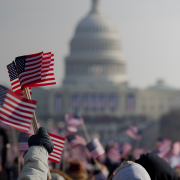
Asia under Bidenomics
- Biden's victory is likely to be positive for Asia in the short run due to reduced trade policy uncertainty and positive spillover effects from higher US spending on infrastructure and clean energy.
- However, Biden’s ‘buy American’ policy, taxes that disincentivize outsourcing and broader China frictions suggest medium-term challenges remain.
- Overall, we believe that Bidenomics would likely be more positive for North Asia in the short run than ASEAN. Over the medium-term, North Asia is likely to face challenges.
Following the recent US elections, we explore the likely impact of Biden’s policies on Asia’s economies.
[Update]
Watch our recent webcast on implication for each country in Asia.
How can Asia benefit from a Biden victory?
Less disruptive trade/foreign policy: Biden is likely to adopt the Obama-era policy of pivoting to the Pacific, which could provide a counterbalance to China and bring about more regional stability. This could benefit US democratic allies (South Korea, Australia, Japan and India) by fostering stronger trade and investment. A more multilateral trade policy approach to resolving disputes also implies a higher probability of the US joining the Trans-Pacific Partnership in the medium-term, which could benefit Asia in terms of trade, investment and overall growth.
Spillover effects from expansionary US fiscal policy: Biden’s fiscal policy proposals are net expansionary. He plans an immediate fiscal stimulus to support the pandemic recovery and US$1.5 trillion in transport and energy infrastructure spending. These should lift US aggregate demand with some spillover effects on Asia as the US accounts for ~12.6% of Asia’s exports on average. The infrastructure push should boost US imports of capital goods, as domestic procurement will likely be insufficient in the short run, benefiting Asia’s key capital goods exporters.
A leg up to Asia’s green exports: Biden’s push towards green energy is well aligned with the vision of countries like South Korea and Singapore and could coalesce into a global effort in this direction. With their early mover advantage, Korea, China and Japan stand to benefit from Biden’s plan to use US$400 billion of federal funding for clean energy inputs such as electric vehicles (EVs), EV batteries and other green technology.
Stable oil prices and weak dollar could emerge as tailwinds: A shift away from fossil fuels and Biden’s plan to re-join the Iran nuclear deal imply more stable oil prices over time, which could benefit large net oil importers such as Thailand, India and the Philippines. We also expect wider US twin deficits to result in a weaker US dollar over the medium-term, which could mean easier global financial conditions.
More immigration relaxations: Expansion of the number of temporary high-skilled visas and an elimination of the limits on employment-based visa by country would benefit countries that account for a large share of the H1-B visa issuance, such as India and China, enabling higher remittances back to home countries.
China to overcome headwinds
Biden favors a more multilateral approach to resolving disputes, instead of bilateral tariffs. There is likely to be more focus on human rights, national security and intellectual property rights under Biden. Tech tensions will remain as Biden has threatened to impose sanctions against Chinese firms that extract US technology by cutting them off from access to US markets. However, this could benefit firms in countries such as Korea in the short run.
It is also worth noting that diversification from China will continue as Biden plans to work with US allies to reduce their supply chain dependence on China, reinforcing the ongoing trend of diversification away from China. So far, this has created winners and losers in Asia, with the main beneficiary being Vietnam.
What challenges do a Biden presidency post for Asia?
US protectionism: A Biden presidency could also set challenges for Asia in various aspects. Biden’s ‘buy American’ policy requires at least 51% domestically made content; his infrastructure plan relies on US-made materials; his tax proposals disincentivize outsourcing. For Asia, this implies that the spillover effects from US spending will be less than in the past and the medium-term trend towards deglobalization will remain a challenge for Asia’s open economies.
US competition for North Asia: In the fields of EV battery technology, lightweight materials, 5G and AI, Biden’s R&D plan aims to make the US globally competitive. While this will take time to bear fruit, the US could directly challenge North Asian economies in these segments in the medium-term.
Risk of higher US inflation: Higher minimum wages, policies for increasing workers’ bargaining power, supply chain disruptions and an accommodative Fed could also contribute to a significantly higher medium-term inflation, triggering tighter financial conditions in Asia.
Overall, we believe that Bidenomics would likely be more positive for North Asia in the short run than ASEAN. Over the medium-term, North Asia is likely to face challenges.
For a deep dive into each economy’s outlook under a Biden election, read our full report here.
Contributor

Sonal Varma
Chief Economist, India and Asia ex-Japan

Ting Lu
Chief China Economist

Euben Paracuelles
Southeast Asia Economist

Jeong Woo Park
Asia Economist
Disclaimer
This content has been prepared by Nomura solely for information purposes, and is not an offer to buy or sell or provide (as the case may be) or a solicitation of an offer to buy or sell or enter into any agreement with respect to any security, product, service (including but not limited to investment advisory services) or investment. The opinions expressed in the content do not constitute investment advice and independent advice should be sought where appropriate.The content contains general information only and does not take into account the individual objectives, financial situation or needs of a person. All information, opinions and estimates expressed in the content are current as of the date of publication, are subject to change without notice, and may become outdated over time. To the extent that any materials or investment services on or referred to in the content are construed to be regulated activities under the local laws of any jurisdiction and are made available to persons resident in such jurisdiction, they shall only be made available through appropriately licenced Nomura entities in that jurisdiction or otherwise through Nomura entities that are exempt from applicable licensing and regulatory requirements in that jurisdiction. For more information please go to https://www.nomuraholdings.com/policy/terms.html.


